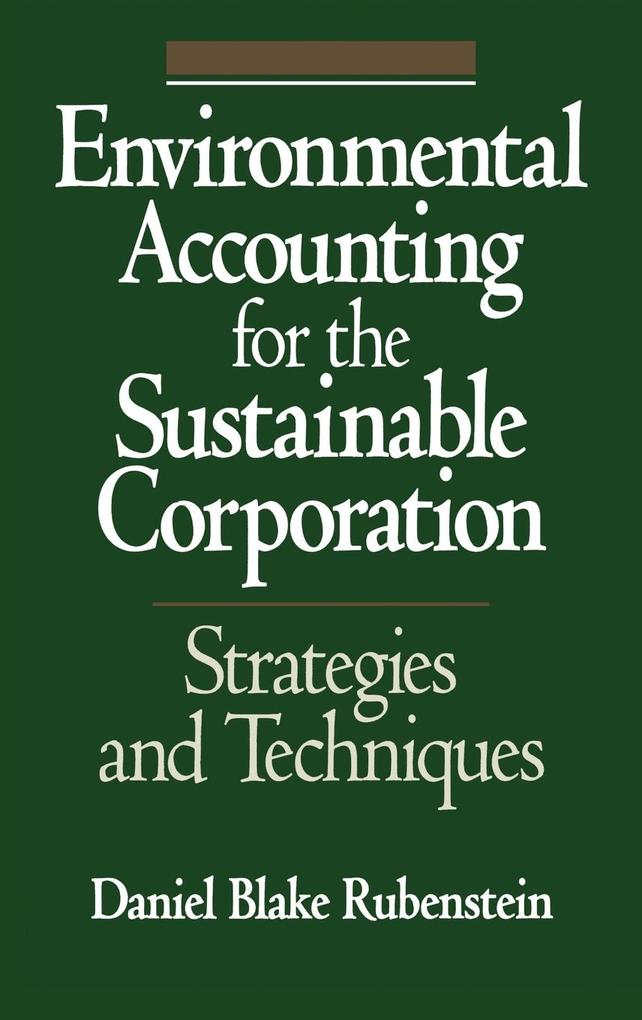
Zustellung: Mi, 23.07. - Sa, 26.07.
Versand in 7 Tagen
VersandkostenfreiCorporations must decide how much to invest in the natural capital (e. g. air, water, land, and forests) that they depend upon for their economic survival. How do they project the costs of essential investments under conditions of scientific and legislative uncertainty? An innovative roadmap is laid out with the help of a case study based on the actual experiences of a forestry company that made such an attempt. Everyone interested in developing a long-range environmental strategy will find this book instructive: senior corporate management, accountants, internal auditors, academics, students, and environmentalists.
Based on the author's research for the United Nations, a new methodology is advanced to compute fuller costs. In addition to practical guidance on the theory and practice of calculating fuller costs, the author illustrates alternatives to traditional capital budgeting models. A whole range of concepts and applications are offered on natural capital; intergenerational equity; waste minimization; asset depletion rates; application of risk-management principles to costing natural capital; off-balance sheet natural assets; modern definition of profit for natural and business capital. Pioneering reporting methods for returns on investment and product costs are recommended in the concluding chapters.
Based on the author's research for the United Nations, a new methodology is advanced to compute fuller costs. In addition to practical guidance on the theory and practice of calculating fuller costs, the author illustrates alternatives to traditional capital budgeting models. A whole range of concepts and applications are offered on natural capital; intergenerational equity; waste minimization; asset depletion rates; application of risk-management principles to costing natural capital; off-balance sheet natural assets; modern definition of profit for natural and business capital. Pioneering reporting methods for returns on investment and product costs are recommended in the concluding chapters.
Inhaltsverzeichnis
Preface
Introduction
Charting a Middle Course
The Limitations of Traditional Accounting
A Guide to Environmental Accounting
Origins of the Concept of Sustainable Development
An Industry Under Intense Public Scrutiny
Negotiating with Today's Stakeholders
Introduction to the Basic Concepts of Natural Forest Capital, Intergenerational Equity and Waste Minimization
Transforming Natural Capital into Product
Valuation of a Forest
A Zero Impact Factory
Applying Risk-Management Principles to Costing Natural Capital
Reporting to the Board on the Stewardship of the Forest
Reporting to Shareholders and Others Who Benefit from the Forest
How Do I Apply This in My Work?
Afterword
References
Introduction
Charting a Middle Course
The Limitations of Traditional Accounting
A Guide to Environmental Accounting
Origins of the Concept of Sustainable Development
An Industry Under Intense Public Scrutiny
Negotiating with Today's Stakeholders
Introduction to the Basic Concepts of Natural Forest Capital, Intergenerational Equity and Waste Minimization
Transforming Natural Capital into Product
Valuation of a Forest
A Zero Impact Factory
Applying Risk-Management Principles to Costing Natural Capital
Reporting to the Board on the Stewardship of the Forest
Reporting to Shareholders and Others Who Benefit from the Forest
How Do I Apply This in My Work?
Afterword
References
Produktdetails
Erscheinungsdatum
30. Juli 1994
Sprache
englisch
Seitenanzahl
224
Autor/Autorin
Daniel B. Rubenstein, John A. Lent
Verlag/Hersteller
Produktart
gebunden
Gewicht
505 g
Größe (L/B/H)
240/161/17 mm
ISBN
9780899308661
Entdecken Sie mehr
Pressestimmen
?Senior corporate managers, accountants, internal auditors, academics and others involved in developing long-range environmental strategy will find this book instructive.?-Environmental Review
Bewertungen
0 Bewertungen
Es wurden noch keine Bewertungen abgegeben. Schreiben Sie die erste Bewertung zu "Environmental Accounting for the Sustainable Corporation" und helfen Sie damit anderen bei der Kaufentscheidung.








